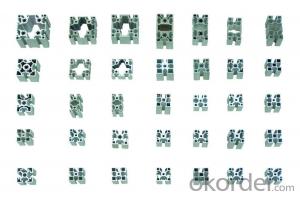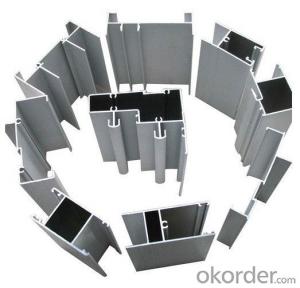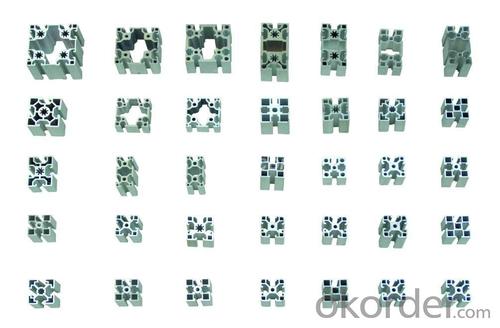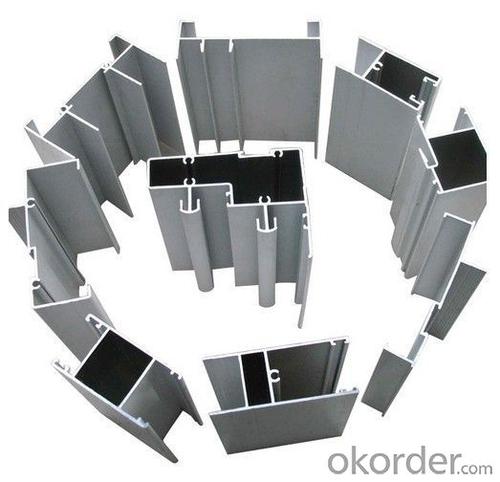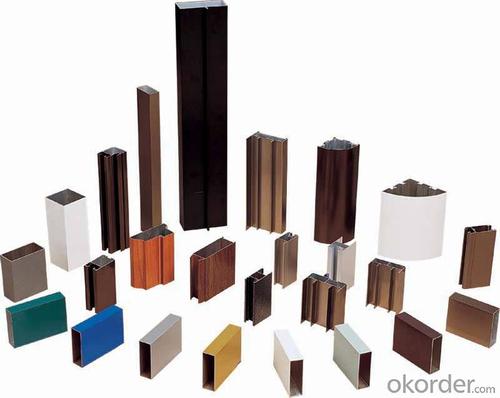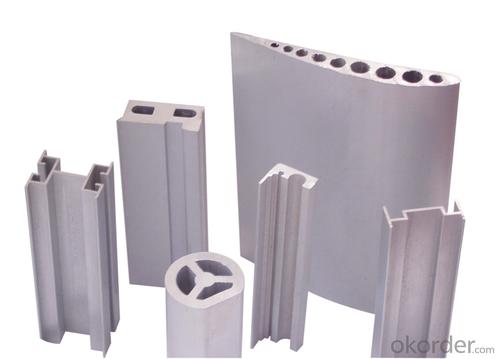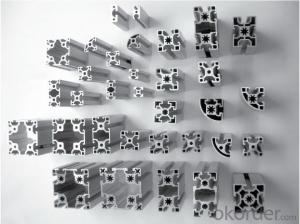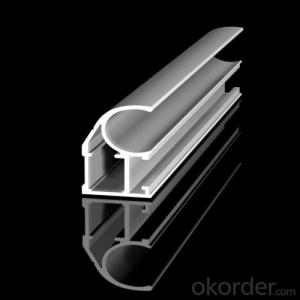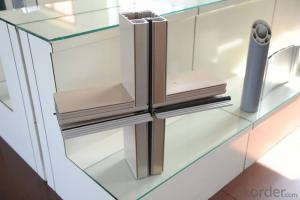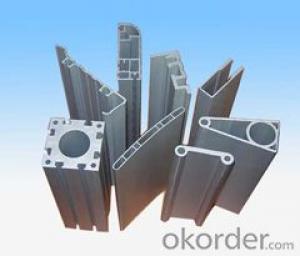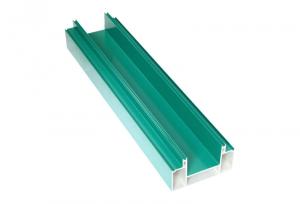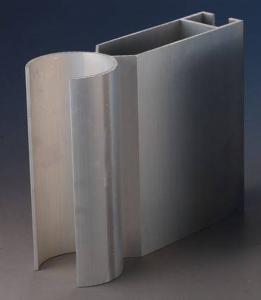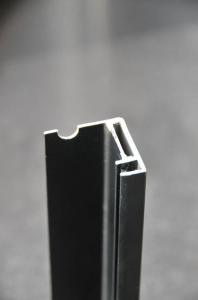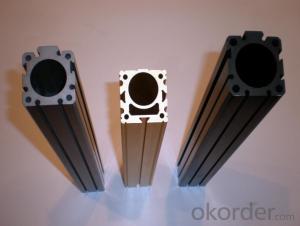Powder Coated Aluminum Profiles for Door and Window Extrusion
- Loading Port:
- China Main Port
- Payment Terms:
- TT OR LC
- Min Order Qty:
- -
- Supply Capability:
- -
OKorder Service Pledge
OKorder Financial Service
You Might Also Like
Aluminium is a relatively soft, durable, lightweight, ductileand malleablemetalwith appearance ranging from silvery to dull gray, depending on the surfaceroughness. It is nonmagnetic and does not easily ignite. A fresh film ofaluminium serves as a good reflector (approximately 92%) of visible lightand an excellent reflector (as much as 98%) of medium and far infraredradiation. The yield strength of pure aluminium is 7–11 MPa,while aluminium alloys have yield strengths ranging from200 MPa to 600 MPa. Aluminium has about one-third the densityand stiffness of steel. It is easily machined,cast, drawn and extruded.
Aluminium alloys (or aluminum alloys; see spellingdifferences) are alloysin which aluminium(Al) is the predominant metal. The typical alloying elements are copper, magnesium,manganese,silicon,tin and zinc. There are twoprincipal classifications, namely casting alloys and wrought alloys, both of which are furthersubdivided into the categories heat-treatableand non-heat-treatable. About 85% of aluminium is used for wrought products,for example rolled plate, foils and extrusions.Cast aluminium alloys yield cost-effective products due to the low meltingpoint, although they generally have lower tensile strengthsthan wrought alloys. The most important cast aluminium alloy system is Al–Si,where the high levels of silicon (4.0–13%) contribute to give good castingcharacteristics. Aluminium alloys are widely used in engineering structures andcomponents where light weight or corrosion resistance is required
Features:
Material | Alloy 6063,6061,6005or according to customer’s choice |
Temper | T3, T4, T5, T6 |
Surface | Anodize, electrophoresis, powder coating, PVDF coating, wood grain painting, matted, etc. |
Length | Coating 6.5 meters, Anodizing 6.5 meters, Mill finish 5 meters |
Application | Industrial, electrical equipment(TV set, air conditioner, refrigerator, computer), decoration,construction, transportation |
Custom Made | We can package following with customer's request. |

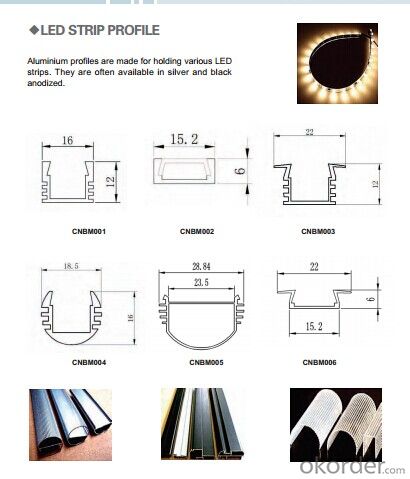
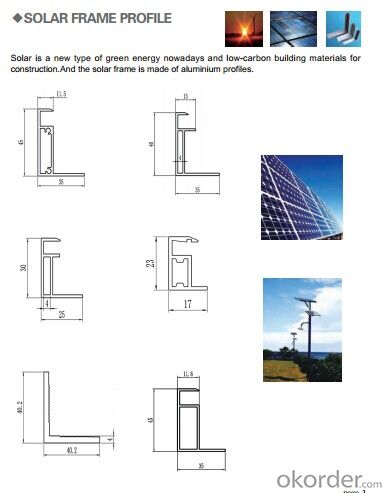
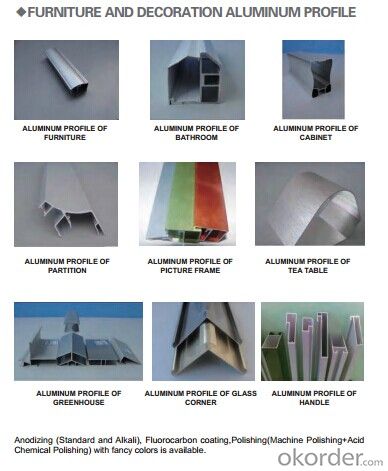
FAQ:
1. What is the form of payment?
Normally 30% TT, L/C at sight
2. Type of quotation?
FOB, CFR, CIF
3. Port of loading?
Shenzhen/Guangzhou port
4. Delivery time?
15-20 days after client’s deposit
- Q: A curtain wall predecessors?For example, under the transverse frame section, with 6m specifications, why should the material processing and minus 50mm? Insert plate, plate to cut 100mm head? What is the law?
- As you said the core insert to reduce 100mm plate plate, this is because the length of processing of these parts is relatively small, some ten centimeters in length, the process if you use a single head saw or double saw large mechanical cutting, base metal processing machinery in a relatively short time finally can not be cut, that is to say the last 100mm~150mm machine cannot continue cutting, it is useless.
- Q: What are the surface finishes available for aluminum profiles?
- Some common surface finishes available for aluminum profiles include anodizing, powder coating, polishing, brushing, and chemical etching.
- Q: How do aluminum profiles contribute to the reduction of noise pollution?
- Aluminum profiles contribute to the reduction of noise pollution in several ways. Firstly, aluminum is a lightweight material that can be used to construct windows and doors with excellent sound insulation properties. These profiles can effectively block and absorb sound waves, preventing outside noise from entering indoor spaces and vice versa. Moreover, aluminum profiles are highly durable and can maintain their structural integrity over time. This durability ensures that the sound insulation properties of the profiles remain effective for an extended period. Unlike other materials, aluminum does not warp or degrade easily, allowing it to consistently provide a barrier against noise pollution. Additionally, aluminum profiles can be designed with special features to enhance their noise reduction capabilities. For instance, manufacturers can incorporate rubber or foam seals into the profiles, which further minimize sound transmission by creating an airtight seal when the windows or doors are closed. These seals effectively block out external noise, creating a quieter and more peaceful indoor environment. Furthermore, aluminum profiles can be customized to fit specific requirements and noise reduction needs. They can be designed with multiple layers of glass, each with different thicknesses and acoustic properties, to provide even higher levels of sound insulation. This customization allows for the creation of tailored solutions to address different levels of noise pollution, making aluminum profiles a versatile option for noise reduction. In summary, aluminum profiles contribute to the reduction of noise pollution through their lightweight yet durable construction, sound insulation properties, and customization options. By blocking and absorbing sound waves, these profiles create a quieter indoor environment, enhancing the overall comfort and quality of life for individuals in both residential and commercial spaces.
- Q: Are aluminum profiles capable of being tailored to fit unique design specifications?
- <p>Yes, aluminum profiles can be customized to meet specific design requirements. This customization includes altering dimensions, surface treatments, and shapes to fit the needs of various applications. Manufacturers can cut, bend, and machine aluminum profiles to precise specifications, allowing for a high degree of flexibility in design and functionality. Customization is often possible through processes like extrusion, which allows for the creation of complex profiles that can be tailored to exacting standards.</p>
- Q: Can aluminum profiles be used in corrosive environments?
- Yes, aluminum profiles can be used in corrosive environments. Aluminum has a natural oxide layer that provides excellent resistance to corrosion. Additionally, it can be further protected by various surface treatments like anodizing or powder coating, enhancing its durability and resistance to corrosive elements.
- Q: This question asks about the methods to ensure that aluminum profiles used in construction meet safety standards.
- <p>To ensure that aluminum profiles used in building construction meet safety standards, you should follow these steps: 1) Source from reputable suppliers who adhere to industry standards. 2) Check for certifications such as ISO 9001 for quality management. 3) Verify the aluminum's grade and alloy type to ensure it's suitable for construction use. 4) Conduct regular inspections and tests, including tensile strength and load-bearing capacity tests. 5) Adhere to local building codes and regulations. 6) Use profiles with appropriate thickness and dimensions for the intended application. 7) Consult with engineers or architects to ensure proper design and installation. 8) Keep records of all tests and inspections for future reference and compliance checks.</p>
- Q: What are the minimum thickness specifications for aluminum alloy door and window profiles?
- The main force member without the minimum wall thickness of aluminum profile measured door surface treatment not less than 2, the window is not less than 1.4, piecing material, horizontal and vertical should be determined through calculation, please refer to the specific GB8478:2008 Aluminum Alloy "window"
- Q: This question asks whether aluminum profiles can be recycled and if so, the process involved in recycling them.
- <p>Yes, aluminum profiles can be recycled. The recycling process typically involves collection, sorting, and shredding the aluminum profiles. After shredding, the material is melted in a furnace, which separates impurities and leaves behind pure aluminum. This molten aluminum can then be cast into new profiles or other products. The recycling of aluminum is energy-efficient and environmentally friendly, as it requires only 5% of the energy needed to produce aluminum from raw materials. This makes aluminum recycling a sustainable practice that helps conserve resources and reduce waste.</p>
- Q: What are the specific features of industrial aluminum profiles?
- Industrial aluminum profile features, we use four words to sum up: a wide range of applications, construction convenience, handsome in appearance, practical, scalable. Remember to adopt yo! Thanks
- Q: How to use aluminum profile on the side of roller conveyor?
- Aluminum profile inside 1 cm thick lining board, our unit of assembly line is like that
Send your message to us
Powder Coated Aluminum Profiles for Door and Window Extrusion
- Loading Port:
- China Main Port
- Payment Terms:
- TT OR LC
- Min Order Qty:
- -
- Supply Capability:
- -
OKorder Service Pledge
OKorder Financial Service
Similar products
Hot products
Hot Searches
Related keywords
